Traffic instruction signs
Traffic instruction signs give you direction and more information about the road you are travelling on.
This extra information can include:
- clearance of structures over the road
- restrictions for vehicle load limits
- climbing and overtaking lanes and turnouts
- steep descents and climbs and safety ramps
- alternative routes
- road flooding depth indicators
- advance instruction for motorways and highways.
Detour and alternative route signs
| Sign | Meaning |
|---|---|
    | Low or load limited bridge ahead with detour signs These signs indicate that there is a bridge, underpass or other structure on or over the road ahead with a height clearance or weight limit. High or heavy vehicles must use the detour shown by the arrow on the sign. |
        | Detour signs for high, heavy, long and wide vehicles These signs indicate that high, heavy, long or wide vehicles must not continue on the route ahead and that a detour is available instead. These vehicles must use the detour shown by the arrow on the sign. |
  | Alternative route signs These signs indicate the direction to follow for the alternative route. |
 | Alternative route for trucks and buses sign These signs show truck and bus drivers the alternative route they need to take. You will usually see this sign with very steep climb or descent signs when not suitable for certain vehicles. |
Heavy or slow vehicle signs
| Sign | Meaning |
|---|---|
 | Very steep climb signs These signs warn drivers that the road climbs steeply for the length shown on the sign. |
 | Very steep climb not suitable for some vehicles signs These signs warn drivers that certain vehicles may find it difficult to drive up the steep climb on the road ahead. These vehicles may include:
|
  | Steep descent signs These signs warn drivers that there is a steep descent or a long steep descent on the road ahead. Long steep descent signs also show the length of the descent. |
 | Very steep descent ahead not suitable for some vehicles signs These signs warn drivers that certain vehicles may not be able to drive down the steep descent on the road ahead safely. These vehicles may include:
Alternative route signs show which way these vehicles can go to avoid the steep descent and continue their journey. |
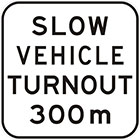 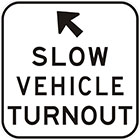 | Slow vehicle turnout signs These signs indicate that slow vehicles can use the turnout ahead on the left. A turnout is where the road widens for a short distance. Slow vehicles can use this area to allow other traffic to pass them. You will see turnouts on low speed roads where there is not enough space for an overtaking lane. |
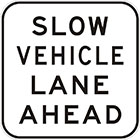 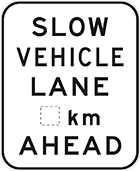  | Slow vehicle lane ahead signs These signs show that there is a slow climb ahead and that slow vehicles must use the left lane. They may also tell you the distance to the start of the slow vehicle lane. |
  | Overtaking lane signs These signs show that an overtaking lane will begin after the distance shown on the sign. |
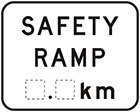   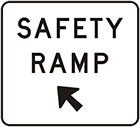  | Safety ramp signs These signs show when there is a safety ramp on the side of the road and the distance to it. Safety ramps allow out-of-control vehicles on steep descents to stop safely. You must not park or stop on a safety ramp, except in an emergency. If there is not enough room for a safety ramp, there may be an arrester bed instead. An arrester bed is a gravel filled ramp that reduces the speed of out of control vehicles. |
  | On right signs These are supplementary signs used with safety ramp signs that are on the right-hand side of the road. |
 | Unsuitable for large vehicles sign These signs show that the traffic area ahead is not suitable for large vehicles to drive through. You might see this sign with a local traffic only sign. |
Local traffic restriction signs
| Sign | Meaning |
|---|---|
  | Local traffic only signs A local traffic sign is for traffic accessing the local area. Through traffic should continue using the main roads. Square-cornered local traffic only signs are used at roadwork sites with detours that allow local traffic into the area. |
 | No through road signs These signs show that the road does not provide passage for continuing journeys. You will see this sign on local roads with a dead end. |
 | Road closed sign These signs indicate that the road is permanently closed to traffic. |
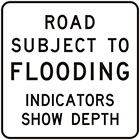  | Road subject to flooding signs These signs show that water may flow over the road ahead. These signs are used at fords and floodways. There will also be depth indicators on the side of the road where these signs refer to them. |
Floodwater depth indicators These signs show the depth of water flowing over the road. They are set with zero at the lowest section of the road. These indicators are used at fords, floodways and low-level bridges. |
Speed and lane information signs
| Sign | Meaning |
|---|---|
 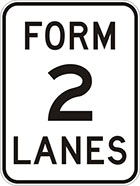  | Form 1 or 2 lanes signs These signs show that the number of lanes on the road you are travelling on will reduce to the number shown on the sign. When you see these signs, you need to merge with other drivers into a remaining lane. They may be accompanied by a supplementary sign showing the distance beyond the sign that the number of lanes will be reduced. |
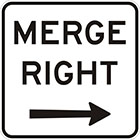 | Merge right signs These signs show that you will need to merge right and join a lane with other drivers. |
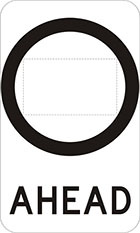 | Speed limit ahead signs These signs show that the speed limit is changing ahead. You should start slowing down to prepare for the lower speed limit. |
 | Reduce speed signs When you see this sign, you must slow down. This sign is installed with other warning signs that indicate the hazard. You may need to stop. |
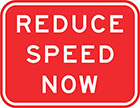 | Reduce speed now signs These signs are installed on motorway exit ramps where you need to slow down and may need to stop. |
 | On bridge signs These signs show that a restriction applies on the bridge ahead. It is only used with a speed limit sign. You must not drive faster than the speed limit shown. |
 | Wrong way signs These signs tell you that you are driving in the wrong direction and you must turn around. You will usually see this sign with or after a no entry sign. |
 | Wrong way—go back signs These signs tell you that you are driving in the wrong direction along an exit ramp of a motorway. You must turn around and go back in the direction you came from. |
 | Winding road ends signs These signs indicate the distance until a winding road will end. You will see these signs where there is a continuous long section of winding road. |
 | End rockfall area signs These signs show that you are leaving an area where loose rocks could fall or roll onto the road from the embankment above. These will follow a falling rocks warning sign. |
Motorway instruction signs
| Sign | Meaning |
|---|---|
  | Prohibited on motorway signs These signs tell you that you can't enter the motorway if you are:
If the sign applies to you, you must take an alternative route. |
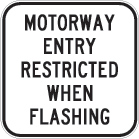 | Motorway entry restricted when flashing signs These signs show that entry onto the motorway will be restricted when the signal is flashing yellow. |
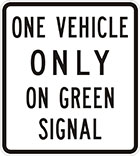 | One vehicle only on green signal signs When you see this sign, only 1 vehicle may enter the motorway when the traffic signal light is green. |
 | One vehicle per lane on green signal signs When you see this sign, only 1 vehicle in each lane may enter the motorway when the traffic signal light is green. |
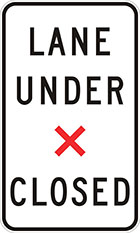 | Lane under X closed signs These signs show that the lane under the red cross is closed to traffic. There may be traffic heading in the opposite direction in the identified lane. You will see this sign with overhead lane control signs. |
 | Emergency median crossing signs These signs are put on median strips on motorways where emergency vehicles can cross it. The median strip will have a crossing lane near the sign that only emergency vehicles are allowed to use to turn. |
   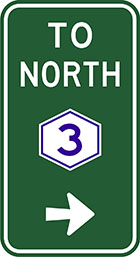 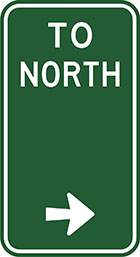 | Motorway approach signs These signs show the route number and direction to the next town or destination listed on the sign. You will see them when you are approaching a motorway. |
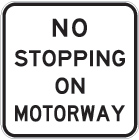 | No stopping on motorway signs These signs remind you that you aren't allowed to stop on the motorway. |
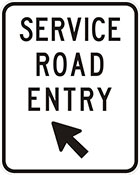 | Service road entry signs These signs show that a service road entrance is ahead on the left. |
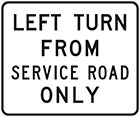 | Left turn from service road only signs These signs tell you that you can only turn left when entering the intersection from the service road. |
  | Designated lane signs These signs indicate which lane you need to be in to turn when you approach the intersection or exit. You will see these signs over traffic lanes on busy, multiple-lane roads when approaching intersections or exits. |
 | Overhead motorway signs These signs show which lane you should be in for a particular:
|
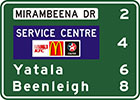 | Reassurance direction signs These signs show you the distance and order of some approaching destinations. This example also shows that 1 of the approaching destinations is a service centre. |
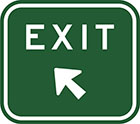 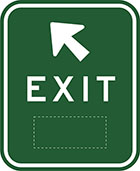 | Exit signs These signs show that you are approaching an exit that turns left off the motorway. The sign may also show the exit number. |
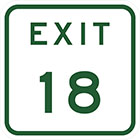 | Exit supplementary signs These signs may be added to direction signs to indicate the motorway exit number where a numbering system is used. |
  | End motorway signs These signs show you that the motorway ends ahead and traffic conditions will change. |
Agricultural area signs
| Sign | Meaning |
|---|---|
 | Sugar cane area signs These signs show that sugar cane is harvested in the area. Drivers should look out for agricultural and heavy vehicles. |
 | Fruit inspection station signs These signs show where there are roadside inspection stations for fruit quarantine checks. |
  | Tick quarantine signs These signs show where there are tick quarantine inspection stations. Vehicles carrying livestock must stop at these stations. |
Railway information signs
| Sign | Meaning |
|---|---|
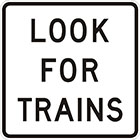 | Look for trains signs These signs warn you to look for approaching trains at the railway crossing. You will see this sign with railway crossing signs. |
  | Railway crossing signs These signs identify a railway crossing. You will see these signs on the side of high-speed rural roads at railway level crossings. |
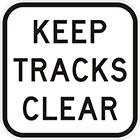 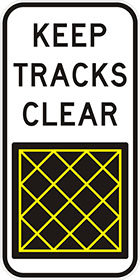 | Keep tracks clear signs These signs tell pedestrians to push the gate to exit a crossing in an emergency. They face pedestrian crossings over tracks at railway crossings. |
 | Emergency exit, push gate signs Pedestrians must push the gate to exit in an emergency. This sign faces pedestrians crossing over tracks at a railway crossing. |
Pedestrian and bicycle rider signs
| Sign | Meaning |
|---|---|
 | Cross with care labels You will see these instructional labels at traffic signals above the pedestrian push-button. When crossing the road at a signalled crossing you must:
|
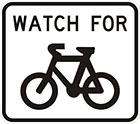 | Watch for bicycles signs These signs warn motorists that bicycle riders may enter the traffic near it because of a road obstruction or hazard. You might see this sign near:
You will see this sign on its own or below a regulatory sign, such as a:
|
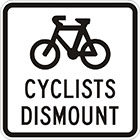 | bicycle riders dismount signs These signs tell bicycle riders that they must get off their bike before crossing the road at a pedestrian crossing. |
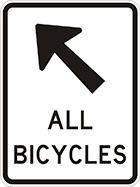 | All bicycles signs All bicycle riders must follow the route or path shown by the arrow on these signs. |
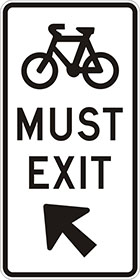 | Bicycles must exit signs These signs show bicycle riders that they must exit the motorway at this sign. |
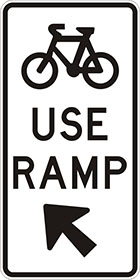 | Bicycles use ramp signs These signs instruct bicycle riders approaching a motorway ramp to use the ramp. Bicycle riders can return to the motorway using the entry ramp ahead or cross the ramp at a defined point to continue along the motorway. |
 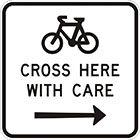 | Bicycles cross here with care signs These signs show bicycle riders where to cross the exit ramp to continue along the motorway. |
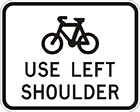 | Bicycles use left shoulder signs These signs tell bicycle riders they must use the left shoulder of the motorway or ramp. |


